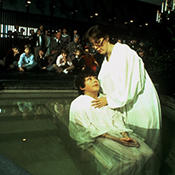 Modeled on Christ’s baptism by John the Baptist in the River Jordan, the rite of baptism involves the partial or full immersion of a person into water as a sign of their rebirth into Christianity. Some denominations baptize infants, while others require that the person has voluntarily chosen to follow Jesus first.
Modeled on Christ’s baptism by John the Baptist in the River Jordan, the rite of baptism involves the partial or full immersion of a person into water as a sign of their rebirth into Christianity. Some denominations baptize infants, while others require that the person has voluntarily chosen to follow Jesus first.
View full album
“Well, this is the end of the road,” said Pastor Chuck Smith of Calvary Chapel to Gary, a new candidate for baptism, looking him straight in the eye. The two of them stood in the ocean, waist deep in the salt water, at the Corona del Mar Beach in Southern California. Gary smiled and said, “Hold me down a long time, Pastor. I’ve got a lot to bury.” Under he went, submitting the weight of his body to Pastor Chuck’s arm. Three times he went into the water. “I baptize you in the name of the Father, and of the Son, and of the Holy Spirit,” the pastor said. When Gary came up for the third time, he was a baptized Christian, the fortieth to be reborn through the rite of baptism that morning.
Baptism is a rite of death and rebirth, the symbolic death of the old person and the rebirth of a new Christian. Being “born again” through baptism is as old as the Christian tradition. Jesus himself was baptized by John the Baptist in the River Jordan. Baptism in rivers and seas is especially evocative of sinking back into the formless waters of the deep that preceded the formation of the created world. The candidate for baptism is immersed in these waters again, and emerges renewed. Baptisms may be in a body of water or in a baptismal tank built within a church. In many Christian churches, however, baptism consists in being sprinkled or anointed with these waters, rather than immersed in them. Whether by immersion or anointing, the ritual of baptism is not so much a remembrance of Christ’s baptism in the River Jordan, as it is a remembrance of Christ’s death and resurrection. By dying and being raised from the dead in imitation of Christ, a person is born into a new kind of life as a Christian and into a new kind of community. Indeed, baptism is the chief rite of initiation into a Christian church.
Churches not only baptize in different ways, but also at different ages. Many churches practice infant baptism, a rite which may include the “christening,” or formal “naming,” of the child. The parents and, in some traditions, the godparents, pledge to nurture the child in the Christian faith, looking forward to the time when they, as a young adult, will personally reaffirm the faith in a rite called “confirmation.” However, in Baptist churches and those following the Anabaptist tradition, infant baptism is rejected. Baptists insist that baptism into the Christian faith must come only when a person is old enough to make their own decisions. Many evangelical Protestants postpone baptism to the age of decision, with the conviction that this important rite should be preceded by a conversion experience, in which the individual comes to accept Christ as one’s own Lord and Savior and desires the rite of baptism as a mark of this transformation. And a few Christian communities, such as the Quakers, do not perform any outward baptism at all, insisting that the inward transformation by the Holy Spirit is the only thing that matters. But whether it occurs at birth or a time of personal decision, the experience of baptism marks one’s entry into the church community and one’s new identity as a Christian.